A male kestrel from yesterday morning and another one from almost exactly two years ago (1/27/22).
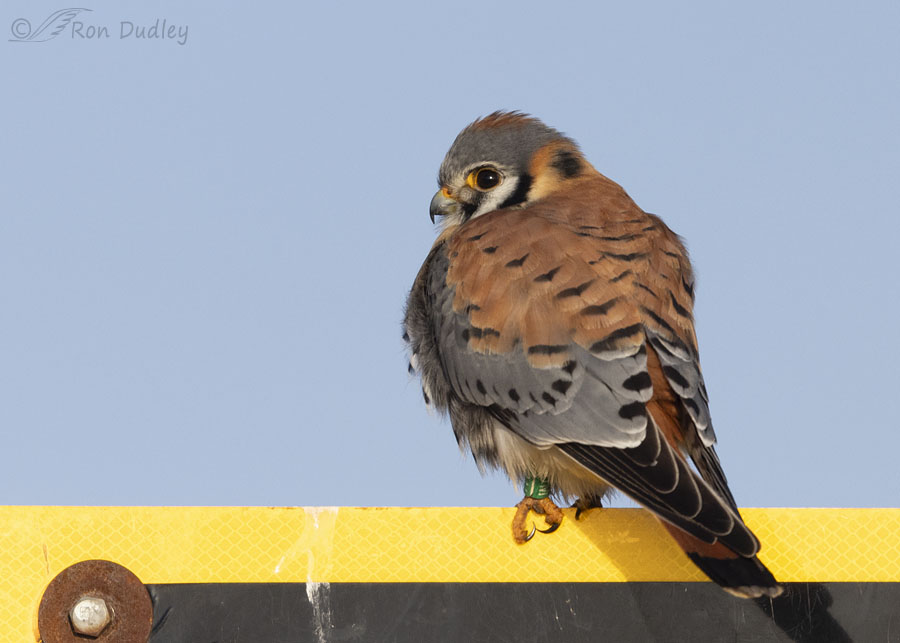
1/4000, f/5.6, ISO 800, Canon R5, Canon EF500mm f/4L IS II USM + 1.4 tc, not baited, set up or called in
Yesterday morning I found this banded male American Kestrel on a traffic sign on Antelope Island. Despite the unappealing perch, I took quite a few photos of him in hopes of being able to read his band numbers/letters well enough to report them to the Bird Banding Lab. But while he was in this spot his lower belly feathers always hid the top half of the green band and some of the information I needed to read.
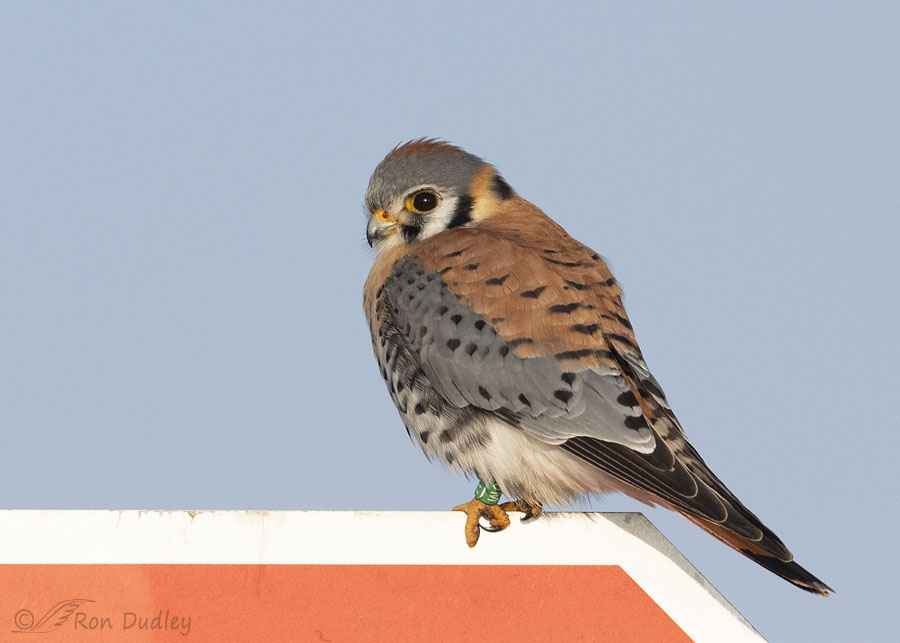
1/5000, f/5.6, ISO 800, Canon R5, Canon EF500mm f/4L IS II USM + 1.4 tc, not baited, set up or called in
After a while an approaching car spooked him off the sign but he landed on another nearby sign that was just as unappealing as the previous one. And while he was here I couldn’t read his entire band either.
However, while he was on the first sign…
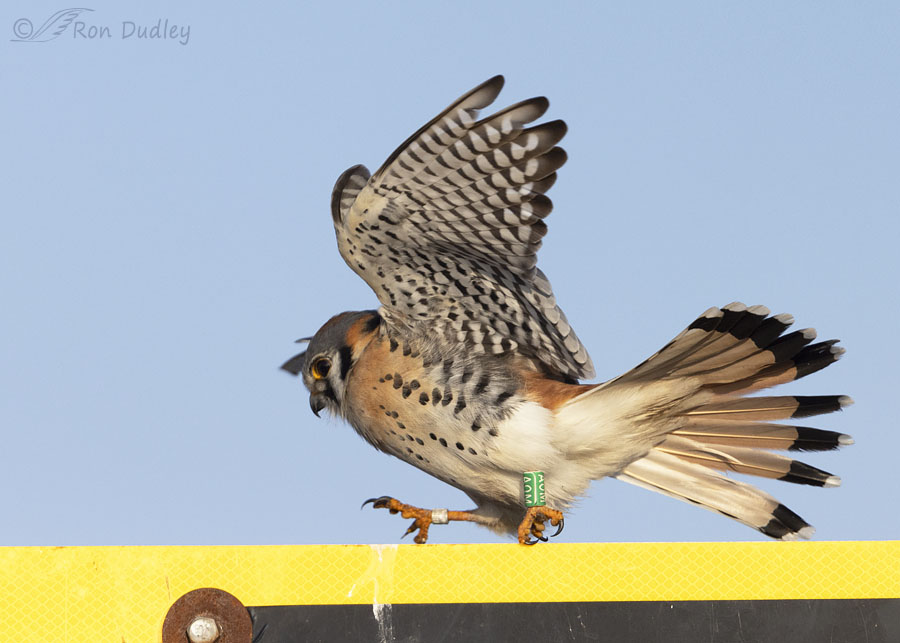
1/5000, f/5.6, ISO 800, Canon R5, Canon EF500mm f/4L IS II USM + 1.4 tc, not baited, set up or called in
another vehicle startled him enough to make him jump and reveal two things that I didn’t realize until I arrived home and looked at my photos on my big screen. In this one shot only, I could read the entire green band on his left leg and see that he was also banded on his right leg with a smaller metal band.
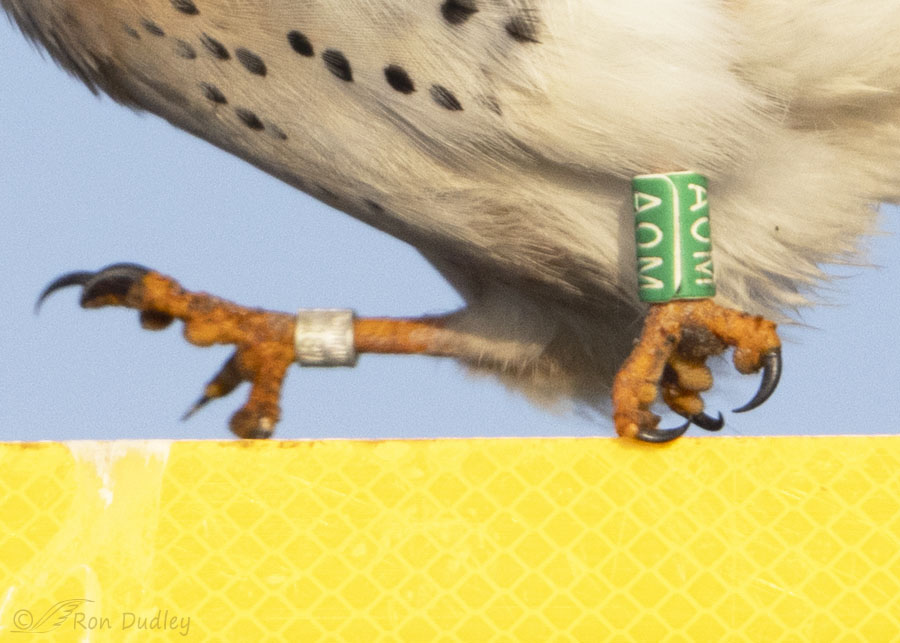
I didn’t have enough depth of field to get the metal band sharp enough to read its numbers but I figured the info on the green band, plus the fact that there was a metal band on the other leg, would probably be enough for the bird to be positively identified.
Around here, most banded kestrels have been banded by HawkWatch International so late yesterday afternoon I sent two of my photos of the kestrel to my friend Nikki Wayment, Executive Director of HWI. She sent them to Jesse Watson, Research Biologist and Banding Coordinator for HWI.
So now I’m waiting to hear back from Jesse. If this bird wasn’t banded by HWI, I’ll send the photos to the Bird Banding Lab.
Before I found this bird yesterday, it was my intention to post a couple of older kestrel flight shots to my blog today. Since those older photos are also of a kestrel, I decided to follow through with my original plan.
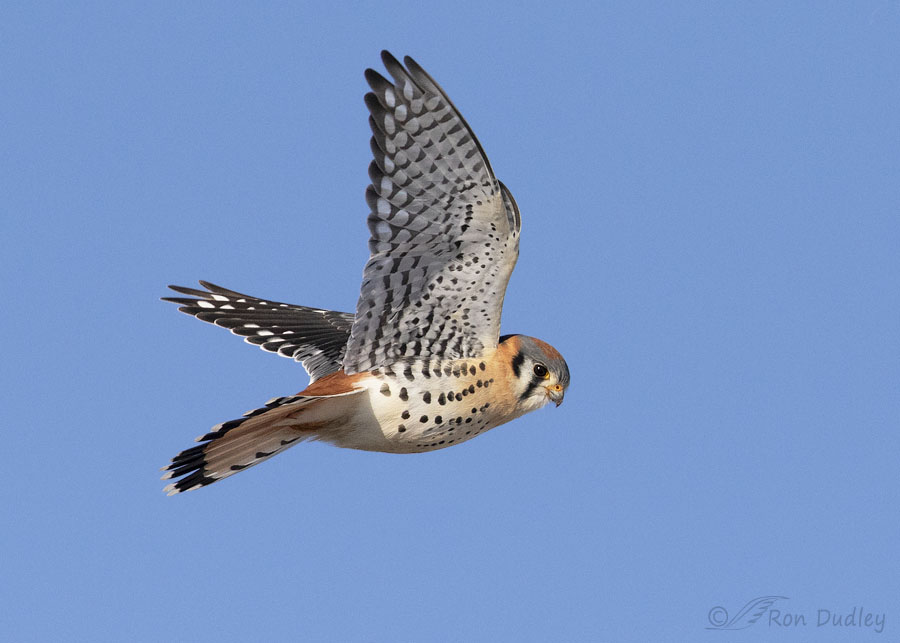
1/5000, f/8, ISO 640, Canon 7D Mark II, Canon EF500mm f/4L IS II USM + 1.4 tc, not baited, set up or called in
It’s unusual for me to get quality flight shots of kestrels and I’d never posted these two before so I couldn’t resist posting them today. I found this guy hovering over potential prey at Farmington Bay WMA and he was actually in pretty good light, which in my experience is unusual for hovering kestrels.
He’s slightly past me but in my judgment that perfect head turn made the photo a pretty darn good one instead of just another mediocre one.
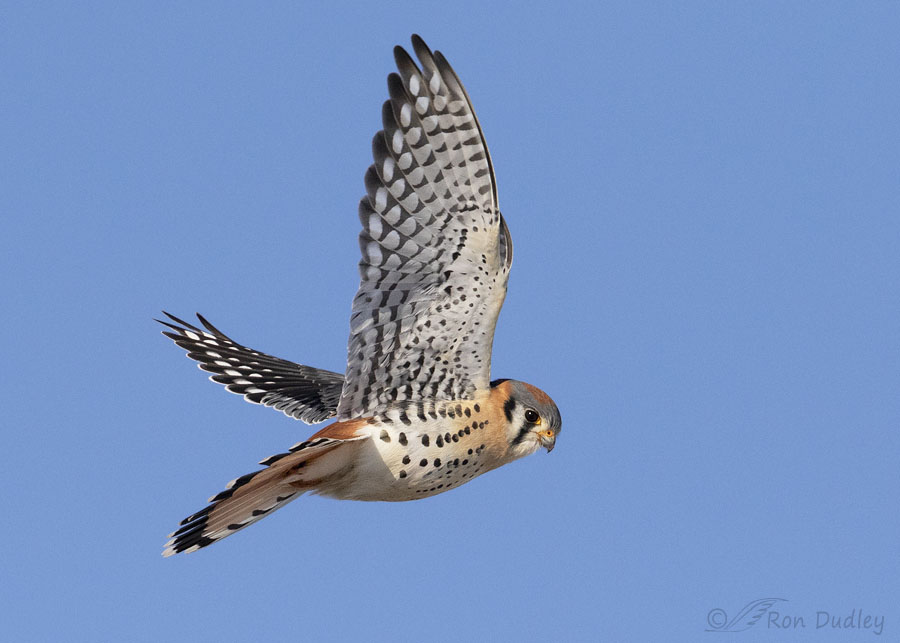
1/5000, f/8, ISO 640, Canon 7D Mark II, Canon EF500mm f/4L IS II USM + 1.4 tc, not baited, set up or called in
Five frames in the burst later I got another photo I like even better because in this shot his right wing is extended even more vertically. When this happens, and the light-colored underside of the wing is facing the sun as it is here, that wing is often (usually?) overexposed. But this time I got lucky with the exposure, probably because the sun was at an oblique angle to the wing’s underside.
If and when I hear back from Jesse or the Bird Banding Lab, I’ll let readers know what I find out about yesterday’s kestrel. They should be able to tell me who banded the bird, when and where he was banded and possibly his age. I always like finding stuff like that out.
Ron


How considerate to allow you one clear look at the bands. I do hope you hear back. Learning a little about the bird’s history is fascinating.
And I really, really like the older photos too. Such a stunning little assassin.
Thanks, EC. Yup, that’s the only shot I got (out of many) where I could read the green band AND even see the metal band.
Sensational!
Thanks, Charlotte.
My first thought on seeing photo #1 was “He and Ron are not happy about this” – sitting on a sign AND banded, way too much human in his little life. But it’ll be interesting to see if the bands can ID him. Which led to a trip to the Bird Banding Lab website and learning about all the different kinds of ID markers out there. (I like the clay-filled one they use on ducklings, the clay wears away as the duckling grows so that it fits the adult leg well!) It is pretty neat to be able to track an individual bird – like the big wing tags on the Condors or the transmitters on the Decorah eagles. Where do those wings take you, Beauty?
“He and Ron are not happy about this.”
You’re right about that, Caroline. You’re right about the reasons why, too – both of them.
My favorite raptors are these guys. I love the coloring so much. 😀
Arwen, there’s lots of color to love in the males of this species.
Beautiful shots Ron – Kestrels are such pretty birds, and all of these shots capture that well. The second flight shot really shows off the underside of the wing, which is usually moving so fast that it’s hard to appreciate. It will be interesting to hear about the banding.
“It will be interesting to hear about the banding.”
I hope someone can ID the bird and send me the info, Bill. It may or may not happen.
Thank you Ron, I always smile when you share your kestrel images <3
“I always smile when you share your kestrel images.”
Good!
Such a beautifully colored bird! Am also Team 1st Older Photo due to the sharpness of the colors.
😊
You may be right about the colors, Kathleen. I probably prefer the second one at least in part because the wing exposure is so good with it in that position relative to the sun. Doesn’t happen very often…
Thanks, Kathleen
Beautiful little assasin as they always are! 😉 Glad you were able to get some banding information that can tell when/where the bird was banded – always neat to find out their travels have taken them…..
They really are stunning birds and you captured them so well. I agree with Michael – I prefer the first of the older shots. It seems the colors are more vibrant. Thanks for the morning treat.
😊
Very nice pictures.
Thanks, Jimmy.
Those last two are excellent shots. Looking forward to learning where and when the first one was banded. I participated in a Kestrel banding here thanks to a Game and Fish friend, and I think I sent you photos of me sitting there holding the tiny few weeks old Kestrel.
Thanks, Everett. I think I remember those photos.
Wow! You made my morning. I’m crazy for Kestrels. No doubt it is because my first bird as a falconer was a Kestrel. These photos are so beautiful! Brought back a flood of memories and emotions. It has been over 30 years, and I am still so grateful I had those days.
How exciting to get photos of one banded. Looking forward to hearing the story.
Have to say, that first “older” kestrel flight shot is my favorite. Yes, the second one shows more right wing. But to me, that first one is in every way so gorgeous. It is classic American Kestrel!
Thank you so much for sharing your work Ron.
Michael, I’m delighted that these photos gave you so much joy.